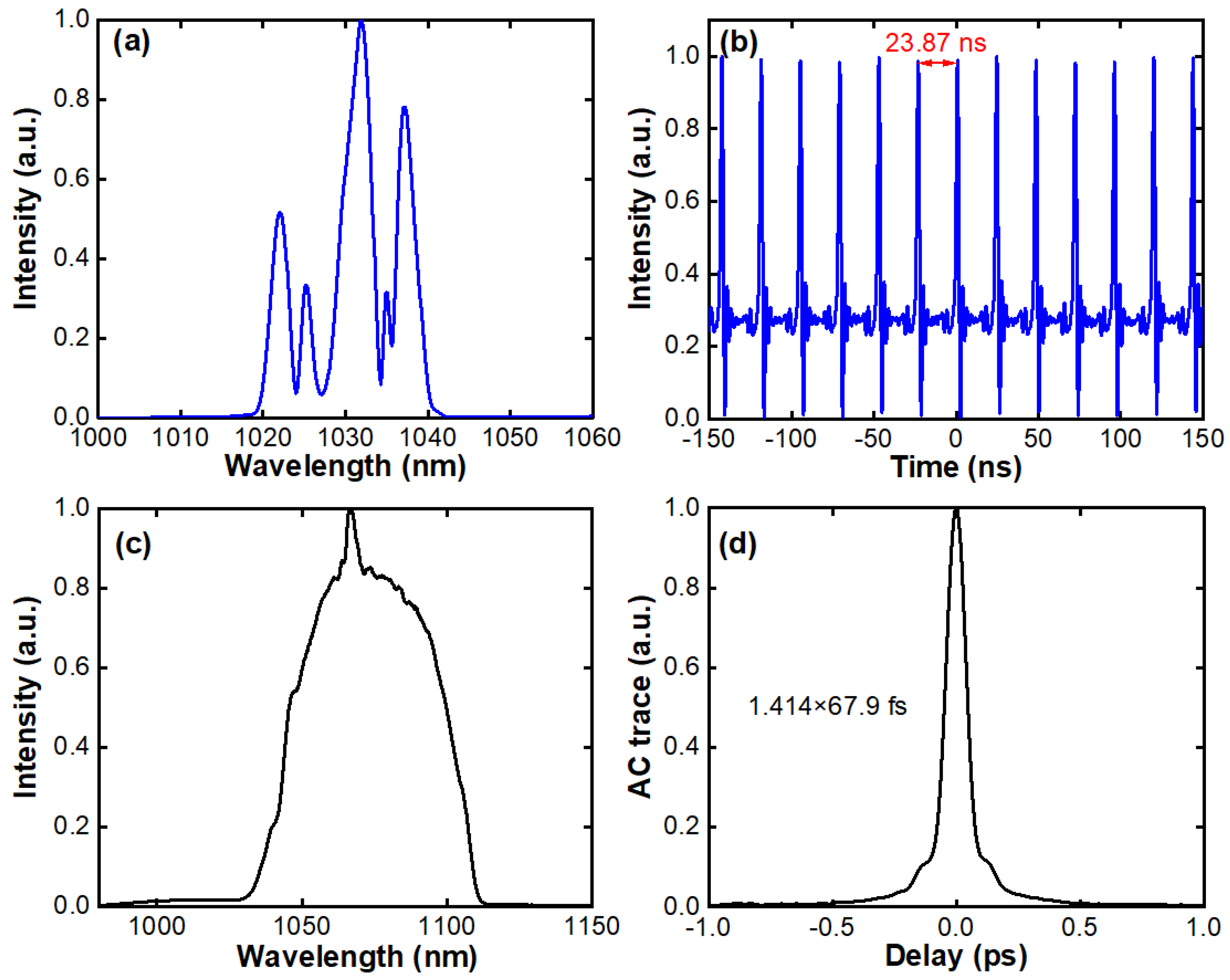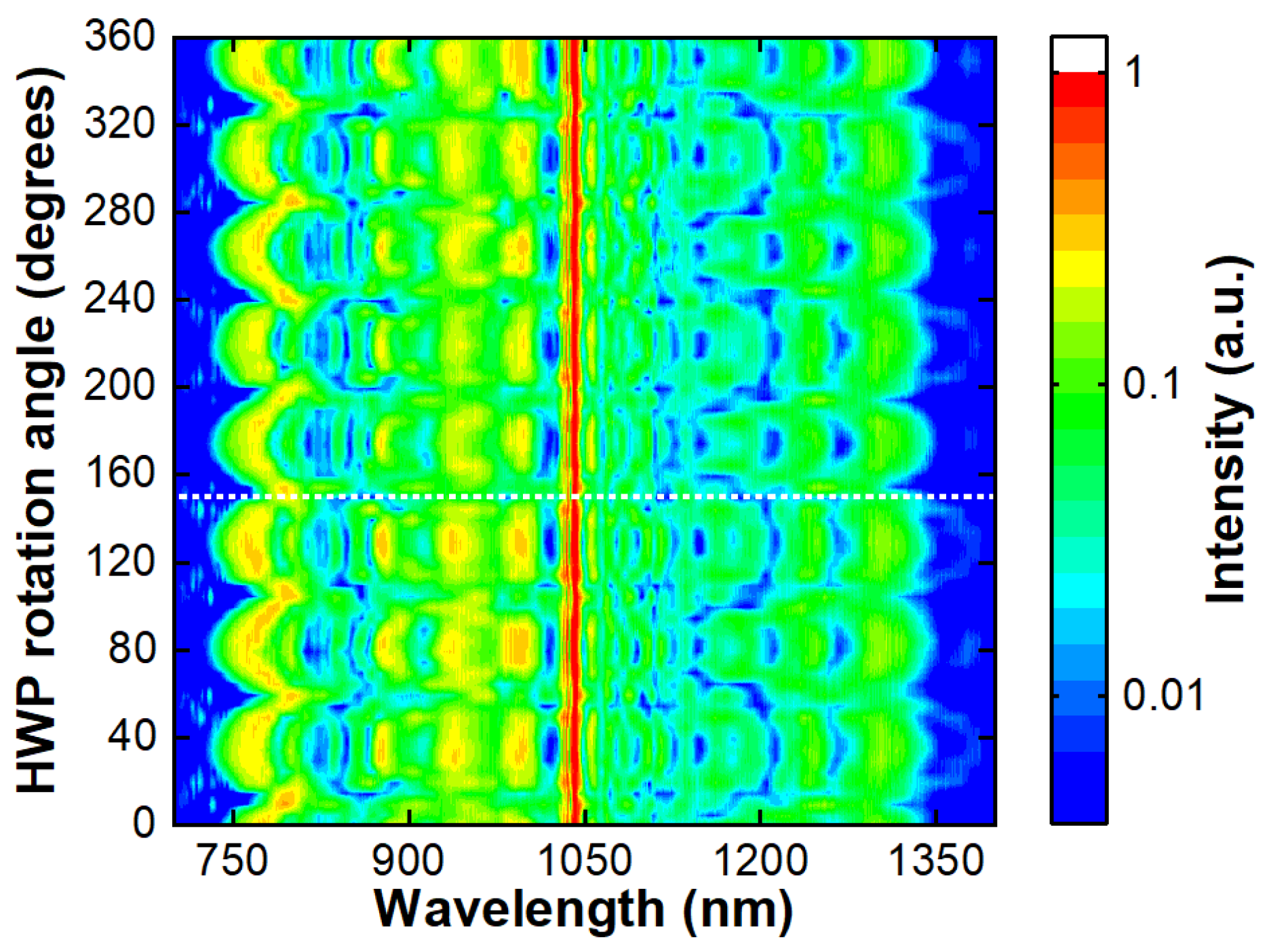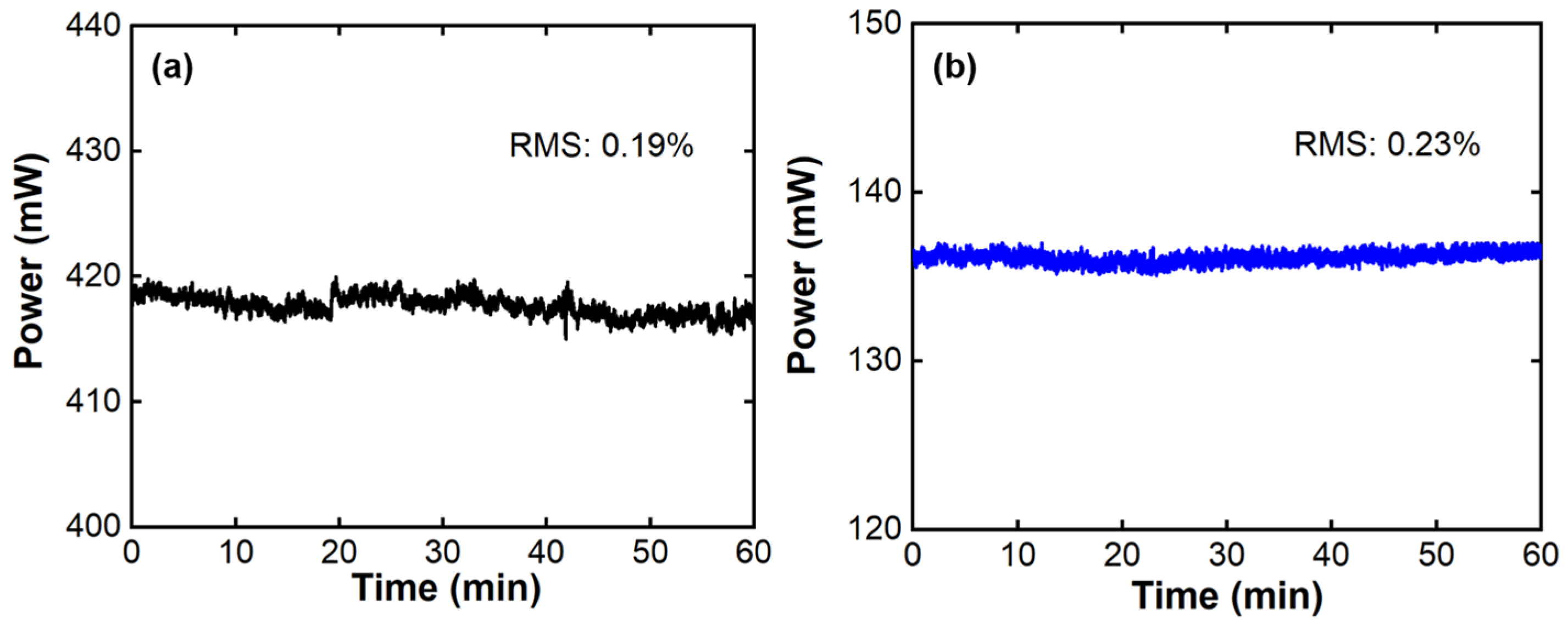Sub-60 fs, 1300 nm Laser Pulses Generation from Soliton Self-Frequency Shift Pumped by Femtosecond Yb-Doped Fiber Laser
Abstract
1. Introduction
2. Experimental Setup
3. Experimental and Numerical Results
4. Conclusions
Author Contributions
Funding
Institutional Review Board Statement
Informed Consent Statement
Data Availability Statement
Conflicts of Interest
References
- Klioutchnikov, A.; Wallace, D.J.; Frosz, M.H.; Zeltner, R.; Sawinski, J.; Pawlak, V.; Voit, K.; Russell, P.S.J.; Kerr, J.N.D. Three-photon head-mounted microscope for imaging deep cortical layers in freely moving rats. Nat. Methods 2020, 17, 509–513. [Google Scholar] [CrossRef]
- Zhao, C.; Chen, S.; Zhang, L.; Zhang, D.; Wu, R.; Hu, Y.; Zeng, F.; Li, Y.; Wu, D.; Yu, F.; et al. Miniature three-photon microscopy maximized for scattered fluorescence collection. Nat. Methods 2023, 20, 617–622. [Google Scholar] [CrossRef]
- Streich, L.; Boffi, J.C.; Wang, L.; Alhalaseh, K.; Barbieri, M.; Rehm, R.; Deivasigamani, S.; Gross, C.T.; Agarwal, A.; Prevedel, R. High-resolution structural and functional deep brain imaging using adaptive optics three-photon microscopy. Nat. Methods 2021, 18, 1253–1258. [Google Scholar] [CrossRef]
- Choe, K.; Hontani, Y.; Wang, T.; Hebert, E.; Ouzounov, D.G.; Lai, K.; Singh, A.; Béguelin, W.; Melnick, M.; Xu, C. Intravital three-photon microscopy allows visualization over the entire depth of mouse lymph nodes. Nat. Immunol. 2022, 23, 330–340. [Google Scholar] [CrossRef]
- Ouzounov, D.G.; Wang, T.; Wang, M.; Feng, D.D.; Horton, N.G.; Cruz-Hernández, J.C.; Cheng, Y.; Reimer, J.; Tolias, A.S.; Nishimura, N.; et al. In vivo three-photon imaging of activity of GCaMP6-labeled neurons deep in intact mouse brain. Nat. Methods 2017, 14, 388–390. [Google Scholar] [CrossRef]
- Schulz, M.; Braatz, T.; Zapolnova, E.; Buß, J.H.; Golz, T.; Indorf, G.; Hofmann, L.; Grguraš, I.; Riedel, R. High power OPCPA system for in-vivo 2- and 3-photon brain imaging. In Proceedings of the Multiphoton Microscopy in the Biomedical Sciences XXI, Online, CA, USA, 6–12 March 2021. [Google Scholar]
- Guesmi, K.; Abdeladim, L.; Tozer, S.; Mahou, P.; Kumamoto, T.; Jurkus, K.; Rigaud, P.; Loulier, K.; Dray, N.; Georges, P.; et al. Dual-color deep-tissue three-photon microscopy with a multiband infrared laser. Light. Sci. Appl. 2018, 7, 12. [Google Scholar] [CrossRef] [PubMed]
- Qin, Y.; Ou, Y.; Cromey, B.; Batjargal, O.; Barton, J.K.; Kieu, K. Watt-level all-fiber optical parametric chirped-pulse amplifier working at 1300nm. Opt. Lett. 2019, 44, 3422–3425. [Google Scholar] [CrossRef] [PubMed]
- Khegai, A.M.; Afanas’ev, F.V.; Riumkin, K.E.; Firstov, S.V.; Khopin, V.F.; Myasnikov, D.V.; Mel’kumov, M.A.; Dianov, E.M. Picosecond 1.3-μm bismuth fibre laser mode-locked by a nonlinear loop mirror. Quantum Electron. 2016, 46, 1077–1081. [Google Scholar] [CrossRef]
- Thipparapu, N.K.; Guo, C.; Umnikov, A.A.; Barua, P.; Taranta, A.; Sahu, J.K. Bismuth-doped all-fiber mode-locked laser operating at 1340 nm. Opt. Lett. 2017, 42, 5102–5105. [Google Scholar] [CrossRef] [PubMed]
- Khegai, A.; Melkumov, M.; Firstov, S.; Riumkin, K.; Gladush, Y.; Alyshev, S.; Lobanov, A.; Khopin, V.; Afanasiev, F.; Nasibulin, A.G.; et al. Bismuth-doped fber laser at 1.32 μm mode-locked by single-walled carbon nanotubes. Opt. Express 2018, 26, 23911–23917. [Google Scholar] [CrossRef]
- Ahmad, H.; Aidit, S.N.; Ooi, S.I.; Samion, M.Z.; Wang, S.; Wang, Y.; Sahu, J.K.; Zamzuri, A.K. 1.3 μm dissipative soliton resonance generation in Bismuth doped fiber laser. Sci. Rep. 2021, 11, 6356. [Google Scholar] [CrossRef]
- Wen, X.; Qiao, T.; Dong, X.; Zhou, M.; Wong, K.K. Bismuth-Doped Fiber Laser at 1.3 μm Mode-Locked by Nonlinear Polarization Rotation. In Proceedings of the Conference on Lasers and Electro-Optics, Charlotte, NC, USA, 5–10 May 2024. [Google Scholar]
- Chung, H.; Liu, W.; Cao, Q.; Song, L.; Kärtner, F.X.; Chang, G. Megawatt peak power tunable femtosecond source based on self-phase modulation enabled spectral selection. Opt. Express 2018, 26, 3684–3695. [Google Scholar] [CrossRef]
- Takayanagi, J.; Sugiura, T.; Yoshida, M.; Nishizawa, N. 1.0–1.7-µm Wavelength-Tunable Ultrashort-Pulse Generation Using Femtosecond Yb-Doped Fiber Laser and Photonic Crystal Fiber. IEEE Photonics Technol. Lett. 2006, 18, 2284–2286. [Google Scholar] [CrossRef]
- Kharenko, D.S.; Efremov, V.D.; Evmenova, E.A.; Babin, S.A. Generation of Raman dissipative solitons near 1.3 microns in a phosphosilicate-fiber cavity. Opt. Express 2018, 26, 15084–15089. [Google Scholar] [CrossRef]
- Gumenyuk, R.; Puustinen, J.; Shubin, A.V.; Bufetov, I.A.; Dianov, E.M.; Okhotnikov, O.G. 1.32 μm mode-locked bismuth-doped fiber laser operating in anomalous and normal dispersion regimes. Opt. Lett. 2013, 38, 4005–4007. [Google Scholar] [CrossRef]
- Rishøj, L.; Prabhakar, G.; Demas, J.; Ramachandran, S. 30 nJ, ~50 fs All-Fiber Source at 1300 nm using Soliton Shifting in LMA HOM Fiber. In Proceedings of the Conference on Lasers and Electro-Optics, San Jose, CA, USA, 5–10 June 2016. [Google Scholar]
- Eisenberg, Y.; Wang, W.; Chen, Y.; Antonio-Lopez, J.E.; Amezcua-Correa, R.; Xu, C.; Wise, F.W. Multi-megawatt pulses from 1030 to 1300 nm based on soliton self-frequency shifting in a nitrogen-filled fiber. Opt. Lett. 2025, 50, 1593–1596. [Google Scholar] [CrossRef] [PubMed]
- Russell, P.S.J.; Hölzer, P.; Wang, W.; Abdolvand, A.; Travers, J.C. Hollow-core photonic crystal fibres for gas-based nonlinear optics. Nat. Photonics 2014, 8, 278–286. [Google Scholar] [CrossRef]
- Liang, X.; Fu, L. Enhanced self-phase modulation enables a 700–900 nm linear compressible continuum for multicolor two-photon microscopy. IEEE J. Sel. Top. Quantum Electron. 2014, 20, 42–49. [Google Scholar] [CrossRef]
- Stoliarov, D.; Koviarov, A.; Korobko, D.; Galiakhmetova, D.; Rafailov, E. Fibre laser system with wavelength tuning in extended telecom range. Opt. Fiber Technol. 2022, 72, 102994. [Google Scholar] [CrossRef]
- Chao, Q.; Wagner, K.H. Polarization instability of Raman solitons ejected during supercontinuum generation. Opt. Express 2015, 23, 33691–33704. [Google Scholar] [CrossRef]
- Sidorenko, P.; Fu, W.; Wise, F. Nonlinear ultrafast fiber amplifiers beyond the gain-narrowing limit. Optica 2019, 6, 1328–1333. [Google Scholar] [CrossRef] [PubMed]
- Nishizawa, N.; Suga, H.; Yamanaka, M. Investigation of dispersion-managed, polarization-maintaining Er-doped figure-nine ultrashort-pulse fiber laser. Opt. Express 2019, 27, 19218–19232. [Google Scholar] [CrossRef] [PubMed]
- Schreiber, T.; Ortaç, B.; Limpert, J.; Tünnermann, A. On the study of pulse evolution in ultra-short pulse mode-locked fiber lasers by numerical simulations. Opt. Express 2007, 15, 8252–8262. [Google Scholar] [CrossRef] [PubMed]
- Voronin, A.A.; Zheltikov, A.M. Soliton self-frequency shift decelerated by self-steepening. Opt. Lett. 2008, 33, 1723–1725. [Google Scholar] [CrossRef]
- Hung, H.; Chou, L.; Chan, C.; Wen, C.; Chia, S. Generation of sub-megawatt peak power femtosecond pulses from a 24 MHz Cr:forsterite oscillator. In Proceedings of the Conference on Lasers and Electro-Optics, San Jose, CA, USA, 9–14 May 2021. [Google Scholar]







Disclaimer/Publisher’s Note: The statements, opinions and data contained in all publications are solely those of the individual author(s) and contributor(s) and not of MDPI and/or the editor(s). MDPI and/or the editor(s) disclaim responsibility for any injury to people or property resulting from any ideas, methods, instructions or products referred to in the content. |
© 2025 by the authors. Licensee MDPI, Basel, Switzerland. This article is an open access article distributed under the terms and conditions of the Creative Commons Attribution (CC BY) license (https://creativecommons.org/licenses/by/4.0/).
Share and Cite
Xuan, H.; Gao, K.; Zou, X.; Zhang, Z.; Qiao, W.; Liu, Y. Sub-60 fs, 1300 nm Laser Pulses Generation from Soliton Self-Frequency Shift Pumped by Femtosecond Yb-Doped Fiber Laser. Photonics 2025, 12, 802. https://doi.org/10.3390/photonics12080802
Xuan H, Gao K, Zou X, Zhang Z, Qiao W, Liu Y. Sub-60 fs, 1300 nm Laser Pulses Generation from Soliton Self-Frequency Shift Pumped by Femtosecond Yb-Doped Fiber Laser. Photonics. 2025; 12(8):802. https://doi.org/10.3390/photonics12080802
Chicago/Turabian StyleXuan, Hongyuan, Kong Gao, Xingyang Zou, Ze Zhang, Wenchao Qiao, and Yizhou Liu. 2025. "Sub-60 fs, 1300 nm Laser Pulses Generation from Soliton Self-Frequency Shift Pumped by Femtosecond Yb-Doped Fiber Laser" Photonics 12, no. 8: 802. https://doi.org/10.3390/photonics12080802
APA StyleXuan, H., Gao, K., Zou, X., Zhang, Z., Qiao, W., & Liu, Y. (2025). Sub-60 fs, 1300 nm Laser Pulses Generation from Soliton Self-Frequency Shift Pumped by Femtosecond Yb-Doped Fiber Laser. Photonics, 12(8), 802. https://doi.org/10.3390/photonics12080802



